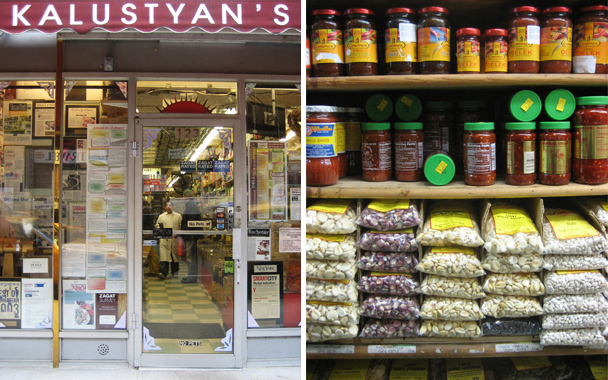Turkey, gravy, cranberry sauce, mashed potatoes, Brussels sprouts, dinner rolls, pumpkin pie… A typical Thanksgiving dinner requires a lot of strategy. You can’t just waltz into the butcher’s next Thursday morning and expect him to have a turkey waiting for you unless you’ve ordered one, and many dishes need to be made ahead if you’re ever going to get everything to the table on time. But in the past few years I’ve developed a ritual that might scare the stuffing out of a Thanksgiving traditionalist: I not only do all my shopping the day before, but I wait until then to plan the entire meal, letting New York City’s shops and markets guide me.
The secret is to focus more on ethnic dishes and fresh produce than on the usual Thanksgiving staples. A good turkey may be hard to come by at the last minute, but the shops and markets of Chinatown are filled with great alternatives. So that’s where I begin. Bright and early Wednesday morning, I take the subway downtown, perhaps to the tiny Bangkok Grocery on the neighborhood’s southern edge, for initial ideas—maybe a first course or dessert will emerge from the shelves of aromatic Thai spices and condiments. Next, it’s on to the open storefronts and street vendors along Mott and Mulberry Streets, where I’ll snag a handful of chestnuts, some fruit, and likely a duck and some fresh whole prawns.
Then, as I do my best to avoid the constant crowds on Canal Street, I bounce up to Little Italy, where perhaps I’ll find a few sausages and cured meats, maybe some fresh pasta dough. I’ll definitely keep an eye out for the guy hacking away at huge slabs of torrone, peddling the sticky sweet from his street cart. By now I have several bags of goodies, but I’ve only just begun, and the menu hasn’t fully revealed itself yet.
That’s when I hop on the subway again, heading to the Union Square Greenmarket, which is always good for inspiration. Without question, the Greenmarket tells us what we should be cooking at any given time of year. Here my bag begins to swell with produce—perhaps a thick bundle of rapini, some slender bulbs of local garlic, maybe a couple of Mutsu apples, a few sweet potatoes, and fragrant sachets of thyme, sage, and parsley. I’ll make the rounds to my usual stalls, grabbing a quart of organic milk from one, farm-fresh eggs from another. I’m tempted by the soil-encrusted salsify and tiny Upstate fingerlings, bulbous squash and earthy beets. At the very least, I’ll pick up some essentials: onions, carrots, celery. Then it’s back into the subway and a few stops further uptown.
If I were pressed to choose my favorite New York City food shop, it might be Kalustyan’s. I’ve been going there regularly for years, yet I almost always find something new with each visit. Located in an enclave of Indian markets and restaurants, the store is well-stocked with ingredients from the subcontinent, but there is also so much more. Its aisles branch out into the Middle East, Asia, and Europe. My shopping trip is nearly halfway through by now, so I’d better make some serious commitments. The milk from the Greenmarket will become fresh mozzarella, so I’ll need rennet and citric acid. For bread, I pick up a package of naan, and to accompany it, incredible za’atar from Lebanon. A handful of Spanish almonds, thick drained yogurt, sugary dried quince, a vanilla bean, Mexican chocolate, and smoky dried peppers begin to fill in the menu.
Then, bypassing the midtown rush hour, the subway takes me up to Katagiri, a Japanese market. I immediately go for the wrinkled green shishito peppers, which are delicate and fairly mild (though it seems about one in five is four-alarm hot). And I’ll look for some Japanese sweets, selecting those with the silliest slogans (e.g. “enjoy your happy relaxation time”). My bags are getting heavy, so I resist any other impulse buys—well, okay, maybe just a sliver of that flawless tuna from the refrigerated case in the back.
As I approach my home turf, I make a detour to my local cheese shop for a hunk of blue, a puck of soft, bloomy chèvre, and maybe an indulgent wedge of aged cheddar. Cheese leads to wine, and the obligatory trio: a sparkling (nothing over-the-top; a humble Cava or Prosecco will do just fine); a floral white such as Viogner or dry Muscat; and if I haven’t already blown the budget, a complex red like Amarone or Côte Rotie.
Once I finally return home, laden to the point where I can carry no more, the day’s catch is dumped onto the table and I go into triage mode, mapping my plan of attack. Most of the cooking happens Thursday afternoon, but I like to begin prep as I put things away. There will still be a few items left to acquire; I’ll find I’m missing some key staples, or I’ll remember some specialty item I missed along the way—a pound of butter, coffee, a half dozen oysters. And of course I’ll need to pick up my nostalgic-but-guilty pleasure for the following day’s breakfast (particularly guilt-inducing for a professional pastry chef): cinnamon rolls, the kind that come in the cardboard tube.




 Pinterest
Pinterest


